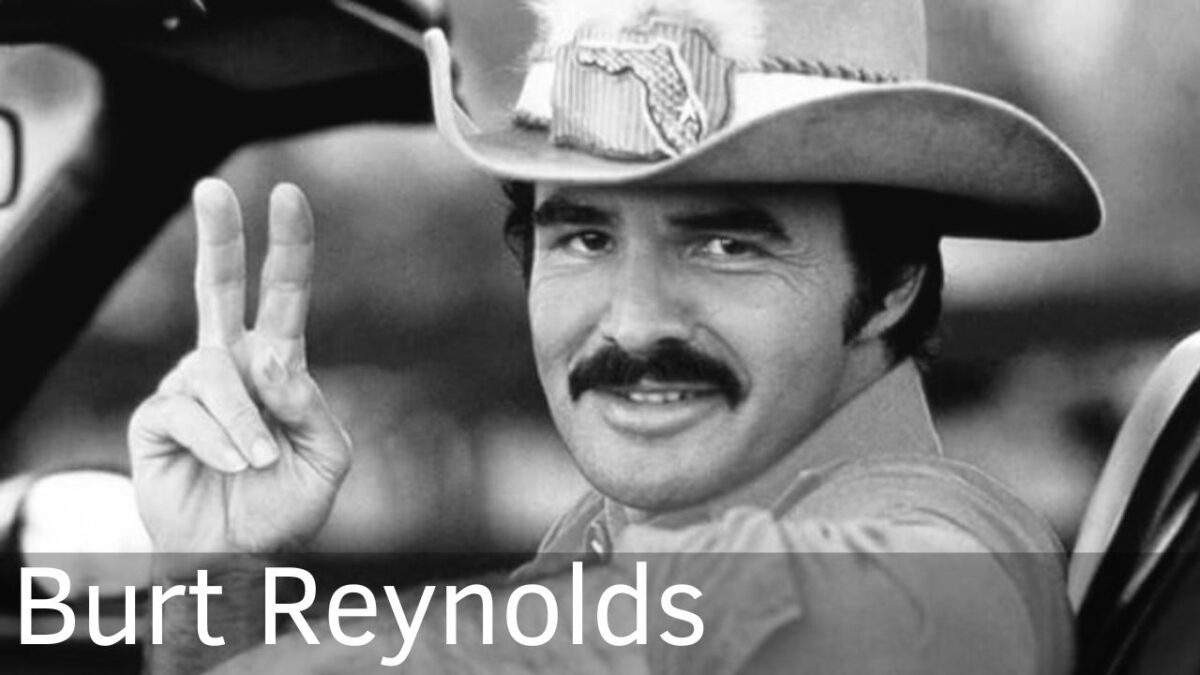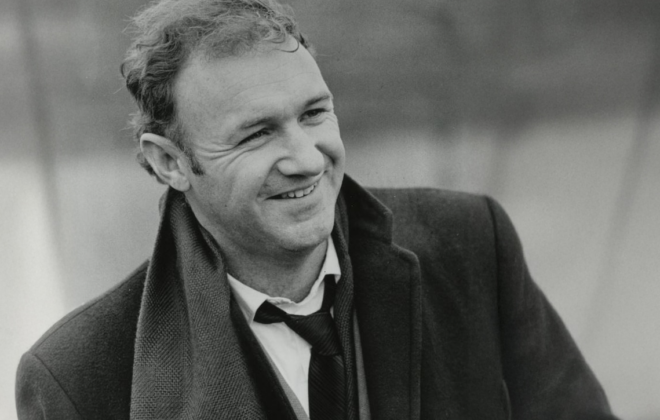Burt Reynolds Biography
Burt Reynolds lived a long and amazing life. Starting his acting career in 1958 and working until the very end, dying at the age of 82, the legendary Burt Reynolds acted, directed, and produced. He became such a prominent sex symbol of the 1970s that he made headlines as the first male to pose nude in a centerfold for the 1972 issue of Cosmopolitan. Burt Reynolds had a long career full of highs and lows both on-screen and off, leaving behind a legacy as one of Hollywood’s most charismatic and enduring stars.
Early Life
Burton Leon Reynolds Jr. was born on February 11, 1936, in Lansing, Michigan. To avoid confusion with his father, he was often called “Buddy.” His father, Burton Milo Reynolds Sr., was drafted into the U.S. Army during World War II, leading the family—his mother, Harriet “Fern,” and older sister, Nancy—to move frequently. While his father was in training, the family lived in places like Fort Leonard Wood, Missouri (nicknamed “Fort Lost in the Woods”). And, while his father was stationed in Europe, his mother relocated the children back to Michigan. After the war, the family settled in Riviera Beach, Florida, where Burton Sr. eventually became the chief of police.
Burt Reynolds grew up with a love of football, playing throughout high school and eventually earning a scholarship to Florida State University, where he joined the varsity team as a freshman. During the first game of his sophomore season, he injured his knee. He underwent a knee surgery that would have allowed him to play again once it healed. However, in December of that year, he was involved in a car accident that left him hospitalized. His spleen had to be removed, and his other knee was also injured, effectively ending his football career.
The following year, Burt enrolled at Palm Beach Junior College. While there, a teacher encouraged him to audition for a school play, where he was cast in the lead role of Outward Bound. In the summer of 1956, Burt received a scholarship to perform in summer stock at the Hyde Park Playhouse in New York. During his time there, he met actress Joanne Woodward, who introduced him to an agent and helped launch his acting career.
That fall, in 1957, Burt Reynolds returned to Florida State and rejoined the college football team. However, the lingering effects of his injuries and being blamed for a game loss led him to quit the team. Afterward, Burt returned to New York to fully focus on his acting career.
Early Career
Reynolds appeared in a few theatrical productions in New York before moving to Hollywood to pursue a screen career. There, he landed small roles in television shows such as Flight (1958-1959) and M Squad (1957-1960). To support himself during this time, he worked various jobs, including as a dishwasher, waiter, and dockworker.
His big break came when he was cast as riverboat pilot Ben Frazer in the series Riverboat (1959-1961). Reynolds left the series after only 20 episodes due to clashes with the lead Darren McGavin. Or, as he tells it he was fired from the show. Either way, he struggled to get roles after that because he picked up a bad reputation. He would occasionally get cast in small parts, often playing the “heavy” or tough guy in various TV series. Then, in 1962, he was cast as Quint in the popular western Gunsmoke (1955-1975). Reynolds enjoyed his time on Gunsmoke but wanted to move into other roles and left the series in 1965, after appearing in 50 episodes.
After leaving Gunsmoke Reynolds starred in the TV series, Hawk (1966–1967), playing Native American detective John Hawk. The show did not last long and was canceled after only 17 episodes.
After the cancellation of Hawk, Reynolds transitioned to the big screen, playing Yaqui Joe in the film 100 Rifles (1969) along with Jim Brown and Raquel Welch.
Career Peak and Injuries
Burt Reynolds’ breakthrough came in 1972 when he co-starred in Deliverance alongside Jon Voight, Ned Beatty, and Ronny Cox. The film was both a critical and financial success, propelling Reynolds to A-list status as a leading man in Hollywood. In Deliverance, Reynolds insisted on performing his own stunts. During one scene, where he went over a waterfall, he cracked his tailbone and nearly drowned. The pain from the injury stayed with him for years.
After Deliverance, Reynolds would go on to star in a series of successful films, including, Shamus (1973), White Lightning (1973), and The Longest Yard (1974). In The Longest Yard, Reynolds got to use some of his former football talent. In it, Reynolds plays a former pro quarterback who is tasked with putting together a prison football team to play against the prison guards. The movie was filmed in an actual prison with prisoners playing some of the players.
In 1977, Reynolds took on the role most people remember him for, the charismatic Bandit in Smokey and the Bandit. This light-hearted action-comedy, written and directed by his close friend Hal Needham, showcased Reynolds as the cool, car-racing Bandit alongside Sally Field. The producers had someone else in mind for the love interest, but Burt pushed for Field to play the runaway bride Bandit picks up hitchhiking. The on-screen chemistry between the two was undeniable, leading to a bit of behind-the-scenes chemistry as well. The idea for the film came about after Reynolds and Needham had been drinking one night. In the movie, Bandit and his partner, played by Jerry Reed, are hired to illegally transport a truckload of Coors beer from Texarkana, where it was legal, to Atlanta, where it wasn’t. Jackie Gleason took on the memorable role of Buford T. Justice, who was determined to stop the Bandit. With a budget of $4.3 million, the film went on to gross over $126 million, becoming the second-highest-grossing movie of 1977, just behind Star Wars.
It wasn’t all action and comedy. Reynolds demonstrated his range in Starting Over (1979), earning him a Golden Globe nomination for Best Actor. After Smokey and The Bandit II (1980), Reynolds was reluctant to star in another car-centric action comedy. However, his friendship with director Hal Needham, and a record-setting $5 million paycheck changed his mind, and he took the lead role in The Cannonball Run (1981). The film features a star-studded cast, including Dom DeLuise, Roger Moore, Farrah Fawcett, Dean Martin, and Sammy Davis Jr., and introduced Jackie Chan to U.S. audiences.
In 1982, Reynolds showed off his singing chops—well, sort of—starring alongside Dolly Parton in The Best Little Whorehouse in Texas. The following year, he teamed up with Loni Anderson in Stroker Ace (1983), who would become his second wife. And of course, he voiced Charlie in the children’s classic All Dogs Go to Heaven (1989)
In City Heat (1984), where Reynolds played a private investigator alongside Clint Eastwood, he suffered another serious injury. This time he was struck in the head with a chair, resulting in a broken jaw. The injury caused him to lose over thirty pounds and led to an addiction to pain pills, ultimately requiring a stay in rehab to recover.
Reynolds occasionally stepped behind the camera as well, directing Gator (1976), the sequel to White Lightning (1973), and Stick (1985). He also directed multiple episodes of his hit TV show Evening Shade (1990–1994).
Missed Opportunities
Scroll through the trivia section of many actor profiles on IMDb and you will read of situations where actors turned down roles they later regretted, and accepting ones they should not have accepted. This is very true in the case of Burt Reynolds. James L. Brooks wrote the role of astronaut Garrett Breedlove in Terms of Endearment (1983) with Reynolds in mind. However, Reynolds declined the role. It then went to Jack Nicholson, who went on to win an Academy Award for Best Supporting Actor. He was also offered the role of Han Solo in Star Wars. Something he later admitted was a misstep to turn down.
By the late ’80s, Reynolds found himself in a series of films that slumped at the box office. He never stopped working and although his big screen career might have declined a bit, he found success on the small screen. Reynolds starred in the sitcom, Evening Shade (1990–94) as former Pittsburgh Steelers player Woodward “Wood” Newton. This role earned him a Primetime Emmy Award for Outstanding Lead Actor in a Comedy Series.
Personal Life
Radiating masculinity, his personal life was often fodder for the tabloids and he would often date his co-stars and other actresses.
In 1963, he met and married his first wife, actress Judy Carne. They met during a publicity tour. However, their marriage was short-lived, marked by fights and bitter accusations. After just two years, the couple divorced in 1965.
While working on Run, Simon, Run (1970) with Inger Stevens, there were rumors of a romantic relationship between the two. And that after an argument Reynolds walked out on her, which allegedly led to her suicide by overdose in April 1970. However, there is no confirmed link between her death and any argument with Reynolds. The exact circumstances surrounding her death remain unclear, and Reynolds never publicly confirmed any direct involvement or specific argument connected to the incident.
In 1971 Reynolds appeared on the Dinah Shore variety show. Even though she was 20 years older the two began dating and would stay together until 1975.
In 1972, Reynolds posed nude for Cosmopolitan magazine. At the time, he thought it was funny but later expressed regret about doing it. I, however, am glad he did. At a former job, if someone left their desk without locking their computer, we’d download the image and set it as their desktop background. Good fun!
Even though Burt Reynolds and Sally Field had met before filming Smokey and the Bandit, it was during the production that their relationship became serious. Reynolds frequently referred to Field as the love of his life. However, according to Sally, she believed his feelings were more rooted in the fact that she wasn’t interested in a long-term relationship, and he was drawn to her because she seemed unattainable. Burt proposed to Sally multiple times, but she was not interested in marriage, which ultimately led to the end of their relationship.
In 1983 Burt married Loni Anderson, whom he had met while filming Stoker Ace. Never having a child of his own, the two adopted a son together. The pair’s tumultuous relationship was followed by a very public divorce in 1994.
He would later date Pam Seals a cocktail waitress. Their relationship also ended badly, with multiple lawsuits.
In addition to his relationship struggles, Reynolds experienced significant financial difficulties. While his divorce from Loni Anderson contributed to the strain, it was primarily his extravagant lifestyle that caused the most damage. He owned multiple properties, including homes in Georgia, a ranch in Florida, and several houses in California. On top of that, he made costly investments in various restaurant chains, which ultimately failed. In 1996, Reynolds declared bankruptcy and was forced to sell some of his homes and other assets. He continued to struggle financially throughout the remainder of his life.
Later Life
Always working, Reynolds had a standout performance in the Demi Moore film Striptease (1996), but it was in 1997 that he experienced a major career resurgence with his role as porn director Jack Horner in Boogie Nights. Initially, Reynolds turned down the role but accepted it due to his financial pressures. Despite his brilliant portrayal, which earned him an Academy Award nomination for Best Supporting Actor, Reynolds did not like making the film. He frequently clashed with director Paul Thomas Anderson on set. However, after receiving the Oscar nomination, his attitude towards it changed.
Reynolds was appropriately cast in The Last Movie Star (2017), where he starred alongside Ariel Winter. Written and directed by Adam Rifkin, the film tells the story of an aging movie star whose glory days are behind him, forcing him to come to terms with his fading stardom—an experience Reynolds could personally relate to. The role was a poignant reflection of Reynolds’ own life, even going so far as to use images from his past performances in the film.
In his later years, Reynolds continued working, popping up in television, including a memorable role in the animated series Archer (2009-2023). He also took on smaller roles in various films.
In 2015, Reynolds published his memoir But Enough About Me, offering candid reflections on his life, career, and relationships. The memoir gave fans insight into his experiences in Hollywood, his personal struggles, and his many high-profile friendships and romances.
Physically, his life and past injuries caught up with him in his later years, leaving him thin and frail. In 2009, he underwent back surgery. The following year, in 2010, he underwent a quintuple coronary artery bypass surgery.
Burt Reynolds passed away on September 6, 2018, at the age of 82. His ashes were placed in the Hollywood Forever Cemetery.
Despite the ups and downs, Burt Reynolds left a permanent mark on Hollywood as someone who lived life to the fullest, spent money like someone who knew he couldn’t take it with him, loved many women, and is loved still by audiences such as myself.
Related Posts
Leave a Reply Cancel reply
This site uses Akismet to reduce spam. Learn how your comment data is processed.





